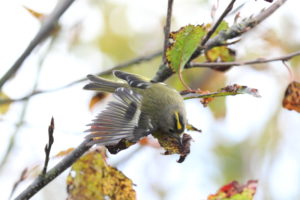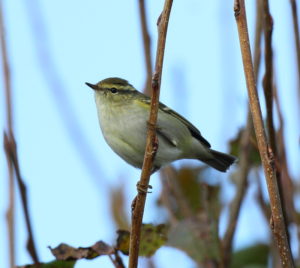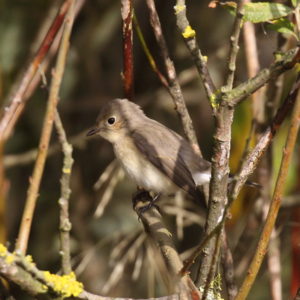
Once again, as on many occasions, Holy Island proved what an outstanding site it is during migration times. Starting in the village, the Vicar’s Garden produced a stunning Pallas’s Warbler, with a couple of Yellow Broweds as supporting cast. Chiffchaffs, Goldcrests and Robins seemed to be in every tree in the village, with Redwings and Fieldfares either feeding on lawns or in the air calling. Several Brambling flew by, calling. A walk down the Straight Lonnen and another Yellow Browed Warbler here giving great views, with the many Goldcrests.
A Great Grey Shrike hunted from bush-tops east of the Lonnen,with another on bushes in the dunes to the north. In the “White’s Thrush bushes”, a Red Breasted Flycatcher entertained quite a crowd, and I was told of 2 others on the Island. 2 Wheatears noted on the walls and a Stonechat or 2 also. Redwings and song Thrushes were almost constantly overhead or feeding in the fields

Later at Snook House a second Pallas’s was found by T. and J. Farooqi, with 2 further Yellow Browed here ( probably 7-8 on the island). More Chiffchaffs and Goldcrests here, with estimates of 300+ of the latter on the island. Robins must have approached 150- 200 too. A Merlin and Short eared Owl hunted the dunes on the north east side of the island and a Barn Owl again along St. Lonnen.
 With temperatures in the sun reaching 18 degreees, several Skylarks briefly sang and around 700 Golden Plover fed in fields with Lapwings. On the mud flats Brent Geese numbers continue to rise and large flocks of Bar tailed Godwits and Knot took to the air as the tide rose. A Spotted Redshank reported near the causeway and several Greenshanks and Little Egrets were feeding here too. A flock of at least 250 Linnets were in stubble at Chare Ends, spooked by a passing Kestrel.
With temperatures in the sun reaching 18 degreees, several Skylarks briefly sang and around 700 Golden Plover fed in fields with Lapwings. On the mud flats Brent Geese numbers continue to rise and large flocks of Bar tailed Godwits and Knot took to the air as the tide rose. A Spotted Redshank reported near the causeway and several Greenshanks and Little Egrets were feeding here too. A flock of at least 250 Linnets were in stubble at Chare Ends, spooked by a passing Kestrel.
A.S.Jack
